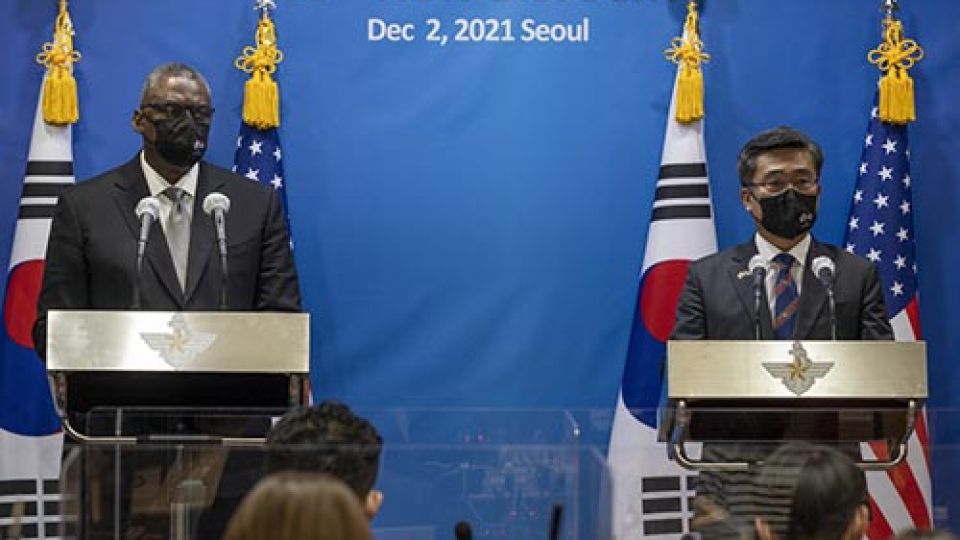December 28, 2021
South Korea’s Defense Ministry on Monday publicly dismissed a former US Forces Korea commander’s opinion that China’s growing military activities and presence in the region should be a key consideration in updating military operational plans.
Boo Seung-chan, the ministry’s spokesperson, elucidated that the South Korean and US defense chiefs agreed on a new Strategic Planning Guidance, “reflecting changes to the strategic environment on the Korean Peninsula.”
“The Strategic Planning Guidance approved by South Korea and US provides guidelines for developing operational plans in response to threats posed by North Korea,” Boo said at a regular news briefing, referring to the outcome of the 53rd Security Consultative Meeting held earlier this month.
South Korea’s official stance is that new OPLANs are needed to more effectively respond to the changing strategic environment, including North Korea’s growing threats, South Korea’s Defense Reform 2.0, and changes in the South Korea-US combined command structure.
The Defense Ministry’s public rebuttal came after former USFK commander Gen. Robert Abrams said China’s growing military activities in and around the Korean Peninsula should be considered in updating OPLANs along with evolving conventional, missile, and nuclear threats by North Korea.
“The last piece, of course, is the People’s Liberation Army under the control and command of the Chinese communist party,” Gen. Abrams said in an interview with Voice of America released on Saturday.
“It’s not a secret that they have increased their presence in and around the Korean Peninsula since 2010. It’s significantly increased.”
Retired Gen. Abrams specifically pointed out that Chinese military planes’ violations of the Korean air defense identification zone (KADIZ) have increased by 300 percent in the last three years.
In addition, there have been growing numbers of Chinese fishing boats illegally fishing along the Northern Limit Line (NLL), the disputed maritime demarcation line on the Western Sea and a flashpoint for inter-Korean conflict. North Korea does not officially recognize the line and its vessels have transgressed across the NLL.
“So these are all indications of things that have to be accounted for in the war plan that the current SPG does not contain,” Gen. Abrams said.
Gen. Abrams underscored the urgency of updating OPLANs to “account for all the changes since 2010” given that the current OPLAN 5015 is based on the SPG approved back in 2010.
The evolving threats posed by North Korea include the development of solid-fuel ballistic missiles, diversified short-range ballistic missiles including submarine-launched ballistic missile, ground-launched cruise missile, and enhanced artillery systems.
Gen. Abrams’ comments ‘out of left field’
In response, South Korea’s Defense Ministry said it does not understand the intent behind Gen. Abrams’ comments especially at a time when Seoul and Washington achieved a top-notch performance at the defense-ministerial Security Consultative Meeting.
Spokesperson Boo said the ministry’s stance was that Gen. Abrams’ comments on China “came terribly out of left field,” specifically refuting the former USFK commander’s point referring to China’s KADIZ violations.
“When military aircraft from neighboring countries enter the Korean air defense identification zone, the Defense Ministry firmly and properly takes countermeasures, including operation of a direct communication channel and tactical action, adhering to the international law,” Boo told reporters.
The Defense Ministry previously acknowledged that Seoul and Washington agreed on updating war plans after a yearslong consultation, hinting its reluctance on the matter.
Gen. Abrams also revealed that South Korea’s Defense Ministry was not “supportive of the need for a new SPG although no specific reason was given” in 2019. Seoul continued to refuse to coordinate on updating an SPG in 2020 even after Gen. Abrams provided a reinforced assessment and review.
In essence, Seoul and Washington are on the same page in updating OPLANs mainly to deal with North Korea’s growing conventional, missile, and nuclear threats, although there are multifaceted determinants for new OPLANs, including the progress in transferring the wartime operational control.
But there appear to be discrepancies between the countries on whether new OPLANs encompass the China challenge and how much focus new OPLANs should put on China’s increasing military activities on and near the Korean Peninsula.
Colin Kahl, US undersecretary of defense for policy, earlier this month said the regional challenges are the key considerations in updating the US-South Korea combined planning on a range of security issues.
“Our planning with South Korea is robust, and it continues to evolve given the evolution of the threat posed by North Korea as well frankly as other challenges in the region,” Kahl said during the Defense One Outlook 2022 event.
“This is just the next turn of the crank in terms of our ongoing planning and the evolution of our alliances with South Korea, which is as strong as it’s ever been.”


